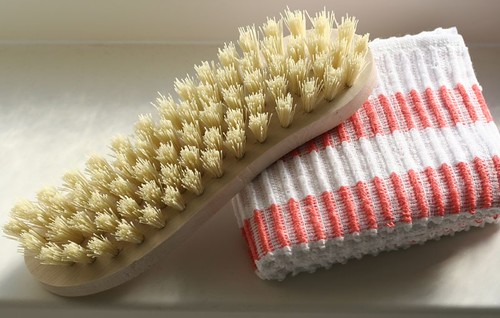Article from HouseLogic.com
By: Alyson McNutt English
Published: September 30, 2009
Make spring cleaning less of a chore by following these smarter–and mostly greener–tips for this annual rite of homeownership.
Spring cleaning is a time-honored tradition. After a long winter, you throw open the windows, let in fresh air, and scrub down the house. But modern spring cleaning presents challenges your grandmother never imagined. Today’s homes are bigger, and the choice of cleaning supplies seemingly endless.
While you’ll need to devote a day or two to this annual maintenance project, make it less of a chore by picking the right tools and methods. And by taking an environmentally friendly approach, you can also protect the well being of your family. Give this space-by-space cleaning guide a whirl this spring-or during any season, for that matter, when grime and clutter become unbearable.
Bathrooms
When it’s time to get down and dirty, many people start with the bathroom . Allen Rathey, founder of The Housekeeping Channel, says removing mineral deposits, rust, and such from toilets doesn’t have to mean chemical warfare. Don rubber gloves and use a pumice stone to erase stubborn stains. If you want more scouring power, Rathey recommends mixing baking soda with acidic vinegar. The concoction is just as effective as conventional cleaners, and there are no toxic fumes to inhale. This approach works equally well on tub and shower stains.
Buy your supplies in bulk to save. A 64-ounce bottle of vinegar costs about $4; a 12-pound bag of baking soda, about $7. Both items can be used throughout the house. For just $1 you can mix equal parts vinegar and water in a 32-ounce spray bottle to make a terrific all-purpose surface cleaner. That’s about $4 cheaper than buying a spray cleaner at the store.
Spring cleaning is the perfect time to extract dirt from porous grouted surfaces. For tile floors use your usual cleaner, but don’t mop. Instead, run a wet/dry vac, which will suck contaminants out of the grout. Mopping drives the grime into the grout rather than removing it. According to Rathey, grout can harbor stinky bacteria that leave a bad odor in the bathroom. This technique is more time-consuming than mopping, but it’s worthwhile to do at least once a year.
Kitchens
The kitchen can be a tough room to clean because there’s usually so much stuff in it, says Justin Klosky, founder and creative director of The OCD Experience, an organizational service. Before you break out the broom, go through your cabinets and drawers, and put together a box of items to donate and a box of items to store somewhere besides the kitchen. Clear your countertops of everything except items you use nearly every day.
After you’ve de-cluttered, you can get to work cleaning. Cloud Conrad, vice president of marketing for cleaning company Maid Brigade, says one tool you shouldn’t overlook is an all-purpose microfiber cloth (about $5). These aren’t run-of-the-mill dusting rags. Microfiber is a densely woven synthetic fabric that picks up dirt and greasy deposits without chemicals thanks to its unique composition. You should be able to clean surfaces like countertops, sinks, and stoves with warm water, a microfiber cloth, and a bit of elbow grease, Conrad says.
Since you prepare your food in the kitchen, consider using green commercial products for surfaces, or make your own vinegar/water spray. Conventional cleaners may remove dirt, but they can also harbor some nasty substances you don’t want in your PB&J. Microfiber, vinegar, and baking soda will clean and disinfect almost every kitchen surface at a fraction of the price. Don’t neglect once-a-year chores like vacuuming refrigerator coils (unplug your fridge first), and tossing out expired food from the back of the pantry.
Bedrooms
Since bedrooms are such individual spaces, there’s a lot of diversity in what needs to happen. Most homeowners should at least rotate and flip innerspring mattresses, and store out-of-season sheets and clothing. Also go through your closet, and donate or Freecycle items you haven’t worn in the last 12 months. For carpets and mattresses, consider using a professional cleaning service. Figure a typical mattress will cost about $70-$90 to clean, a bargain considering how much time you spend in bed.
Even if you’re getting your carpet professionally cleaned, you still need to break out the vacuum, says Leslie Reichert, owner of The Cleaning Coach. Use the hose attachment to get to the hidden particles along baseboards, under your bed, and in your curtains, favorite environments of dust mites. If you have a large-capacity dryer, throw curtains in on high heat for good measure to kill the little pests.
Living area
Another surface you should consider getting professionally cleaned is living room upholstery. It can be tricky to know exactly how to deep-clean different types of fabrics, says Rathey, especially if there are stains you can’t quite identify. Costs vary widely depending on the size of the furniture piece and the quality and state of its covering, but a typical sofa might run $70 to $90.
Microfiber cloths are great to use in the living area as well. Make sure you have cloths for each area of the house, though, so you’re not cross-contaminating bathroom, kitchen, and living areas. Use a damp microfiber cloth to wipe down windows (http://www.houselogic.com/articles/green-window-cleaning-makes-glass-pane-fully-clear/), wood, mirrors, the tops of bookshelves, ceiling fan blades, and even the plastic housing of electronics for a quick, chemical-free clean.
Alyson McNutt English has written about keeping a house healthy and clean for publications like Pregnancy, Conceive, and BobVila.com. A big believer in baking soda, vinegar, and microfiber, she likes to do her "spring cleaning" in the fall.
Visit HouseLogic for more articles like this. Reprinted from HouseLogic with permission of the National Association of REALTORS. Copyright 2001. All rights reserved.
Thanks for reading the First Weber Wisconsin real estate & Wisconsin living blog. Hope you found these tips helpful!
